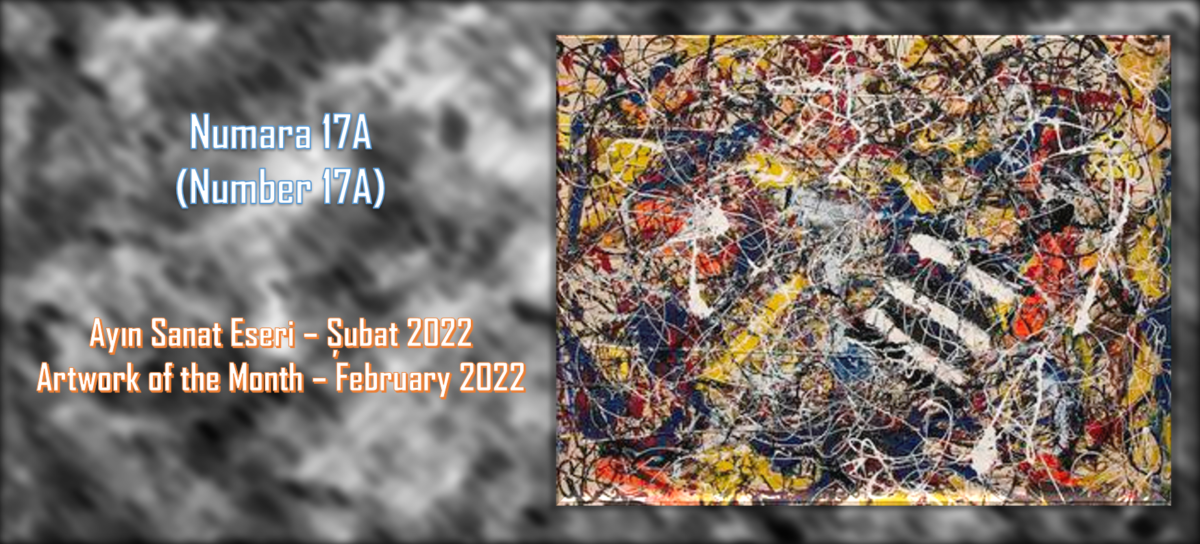Bu ay #GüvenlikPortalı’nın kapak fotoğrafı, Amerikan Soyut Dışavurumcularından Jackson Pollock’ın 1948 tarihli Number 17A eseri.
Soğuk Savaş’ın geri döndüğü veya dünyanın yeni bir büyük savaşın içinde olduğu iddialarının konuşulduğu 21. yüzyılın ilk çeyreğinden geriye dönüp bakıldığında, sanatın savaş veya büyük güçler arasındaki gerginliklerden sadece savaşla ilgili somut üretimler şeklinde değil, üretim tarzı veya sanat akımları nezdinde de etkilendiği görülür. Soğuk Savaş’ın sanat alanındaki yansımaları, döneminin ideolojik ve kültürel rekabetini yansıtan propaganda savaşı çerçevesinde gerçekleşmiştir. Sovyetler Birliği’nin parti kontrollü devlet yönetimi ve toplumsal hayatı, sanatsal üretimi de etkileyerek konusunu günlük yaşam ve üretim ilişkilerinden temel alan, Sosyalist Realizm olarak anılan gerçekçi tarzda yapılmış tabloların hakimiyetinde bir sanat anlayışı getirmiştir. ABD ise bu anlayışa alternatif olarak, tuval üzerinde sadece renkler veya çizgiler olsa da bunun sanat olarak kabul edilmesinin Amerikan özgürlüğünü temsil ettiği düşüncesiyle soyut sanatı, daha sonra alacağı ismiyle Amerikan Soyut Dışavurumculuğunu, desteklemiştir.
Dönemin propaganda savaşı kapsamında dünyanın çeşitli yerlerindeki basın-yayın organlarının ve film endüstrisinin desteklenmesinin ötesinde, Amerikan caz, opera ve klasik müzik sanatçıları ve gruplarının desteklenerek dünya turlarının finansmanı da sağlanmıştı. Fakat yeni bir sanat akımının desteklenmesi, özellikle de bunun kitleler tarafından anlaşılması ve beğenilmesi daha zor olan soyut dışavurumculuk olması, sanat tarihi açısından önemli bir akımın siyasetle ne derece ilişkili olarak ön plana çıktığını göstermiştir.
Jackson Pollock, Willem de Kooning, Mark Rothko gibi önemli isimlerin öne çıktığı soyut dışavurumcuların arasında Troçkistler, Leninistler, anarşistler gibi dönemin McCarty’ci ABD ideolojisine göre makul sayılmayan sanatçılar olması bu durumu daha ilginç hale getirmektedir. Bu durum, Sovyet Realizmin kuralcılığına ve katılığına karşı, sosyalistlerin farklı üretimlerinin de ABD’de kabul gördüğü mesajını vermek açısından oldukça işlevsel olmuştur.
Amerikan Soyut Dışavurumculuğunun desteklenmesi, Rönesans’tan günümüze geçerli olan sanatçı-sponsor ilişkisinin işler örneğidir. Bu eserler çeşitli iş insanlarının kurdukları vakıfların sağladıkları destekler ve MoMA (Museum of Modern Art) gibi büyük müzelerin imkanları sayesinde kitlelere ulaşma ve popülerleşme imkânı bulurken, tüm bu yolları açanın ve fonları sağlayanın ise aslında resmî kurumlar olduğu kamuoyundan uzun süre gizli tutulmuştur. 1950’ler ve 60’lar boyunca süren bu örtülü destek, New York’un dünyanın sanat merkezi olarak öne çıkmasına da katkıda bulunmuştur.
Amerikan soyut dışavurumculuğunun temsilcileri elde ettikleri popülerlik sonucu ün sahibi olmuş ve tabloları yüksek fiyatla alıcı bulan, dünyanın her yerinde müzelerde karşılaşılan, aranılan eserler haline gelmiştir. Bunların arasında Jackson Pollock’ın Number 17A isimli tablosu 2015’te 200 milyon dolara satılarak dünyanın en pahalı tablolarından biri olmuştur. Boyanın damlatılması yöntemiyle yapılan bu tablo yapıldığı dönemde önyargılarla karşılaşmış fakat 1949’da Life dergisinde konu edinildikten sonra büyük popülarite kazanmıştır.
***
This month’s cover photo of #SecurityPortal is the artwork of American artist Jackson Pollock, dated 1948, Number 17A.
Looking back from the first quarter of the 21st century, when the claims that the Cold War has returned or that the world is in a new great war are discussed, it is seen that art has not been affected by the war only through production style of the artists but also art movements are reshaped by the war and conflict. The reflections of the Cold War in art were realized within the framework of the propaganda war, which reflects the ideological and cultural competition of the period. The party-controlled state administration and social life of the Soviet Union also influenced artistic production, bringing an understanding of art dominated by realistic paintings called Socialist Realism, which is based on production relations. As an alternative to this understanding, the US-supported abstract art, later known as American Abstract Expressionism, with the thought that even if there are only colors or lines on the canvas, they accepted these products as an art representing American freedom.
Within the scope of the propaganda war of the period, beyond the support of the media and the film industry, world tours of American jazz, opera, and classical music artists and groups were financed. However, the support of a new art movement, especially abstract expressionism, which is more difficult to be understood and appreciated by the masses, has shown how an important movement in art history has come to the fore in relation to politics.
The fact that among the abstract expressionists, whose important names such as Jackson Pollock, Willem de Kooning, and Mark Rothko came to the fore, were artists such as Trotskyists, Leninists, anarchists, who were not considered reasonable according to the McCartyist US ideology of the period, which makes this situation more interesting. This situation has been very functional in terms of giving the message that different productions of socialists are accepted in the USA against the rule and rigidity of Soviet Realism.
The promotion of American Abstract Expressionism is a working example of the artist-sponsor relationship that has been valid from the Renaissance to the present. While these works were able to reach the masses and become popular thanks to the support provided by the foundations established by various business people and the opportunities of large museums such as MoMA, they were kept secret from the public for a long time that it was the official institutions that opened all these roads and provided the funds. This implicit support throughout the 1950s and 60s also contributed to New York’s prominence as the world’s art center.
Representatives of American abstract expressionism became famous as a result of the popularity they achieved, and their paintings became sought-after works found in museums all over the world, finding buyers at high prices. Among them, Jackson Pollock’s painting Number 17A has become one of the most expensive paintings in the World at 200 million dollars. This painting, made by drip technique, faced prejudices at the time it was made, but gained great popularity after it was featured in Life magazine in 1949.
Kaynakça (Reference)
Eva Coccroft, ‘Abstract Expressionism, Weapon of the Cold War’, in Francis Frascina ed., Pollock and After: The Critical Debate, Harper&Row, 1985.
https://www.independent.co.uk/news/world/modern-art-was-cia-weapon-1578808.html
https://www.bbc.com/culture/article/20161004-was-modern-art-a-weapon-of-the-cia
https://www.jackson-pollock.org/number-17a.jsp

